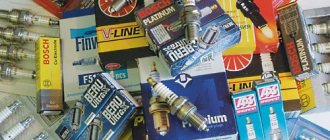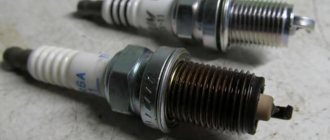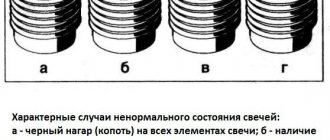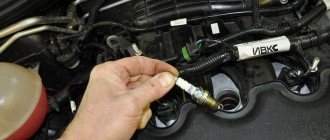A gasoline engine cannot live without a spark plug! It is a simple spark gap with central and side electrodes. An arc forms between them, igniting the compressed mixture of fuel and air at the required periods of time. It is difficult to work as a kind of “match”, since temperature conditions have a wide range. Deposits on the parts of the ignition element and the battery, which can “get tired” both suddenly and during short trips within the city, contribute.
How to diagnose spark plugs based on appearance: black carbon
A dark, opaque coating on the electrodes can indicate numerous problems. Before analyzing them, let us divide black formations according to their structure into three independent groups:
- Oily (wet deposits).
- Velvety or loose (dry soot).
- Solid.
Oily texture
In response to the presence of oily deposits, diagnostics of spark plugs based on the appearance of the insulator will issue an expert conclusion - oil is entering the combustion chamber. Electrodes are wet due to lubricant - major repairs cannot be avoided. The situation shown in the photo can happen for three reasons:
- Valve seals are worn out.
- The life of the piston rings is coming to an end.
- The valve guides are broken.
Compression measurements will help separate the culprits. If it is normal, then the problem is related to the tightness of the valves. The following aspect also has the right to life: the thread in the oil is the reason in the cylinder head (with bushings/valve caps). It is possible that lubricant may leak from under the valve cover through the spark plug well.
In parallel with the deposition of oil on the electrodes of the spark plugs, the muffler emits white-blue gases. Another possible symptom is the power plant tripping at the beginning of warm-up.
For reference. A particular variation of the signs of an oil-air emulsion entering the combustion chamber is ash deposits. This deposit occurs due to the combustion of the additive package included in the oil by the manufacturer. If this fact is discovered, the rings should be decarbonized.
Loose black dry soot
Velvety black color primarily indicates increased fuel consumption. It may be caused by improper carburetor adjustment. On an injection engine, the reason may lie in the malfunctioning of the ECU, associated with incorrect readings of some sensors. A clogged air filter will also cause the mixture to become over-rich.
A matte, loose black coating also appears during prolonged operation of the internal combustion engine at idle or short trips within the city. It is noteworthy that this structure is formed only on the electrodes. The thread remains clean. More detailed reasons are considered separately for the methods of preparing fuel assemblies and will be given below.
Hard black deposits
Such deposits indicate one thing - the spark plug does not correspond to the engine in terms of temperature characteristics. In other words, the igniter has too high a heat value. In fact, this indicates that the product is “cold”, that is, its self-cleaning temperature in the combustion chamber is not reached.
Candles in oil
In used engines, engine diagnostics using spark plugs can help identify problems with increased oil appetite. Oil on a spark plug can often be found on the threads. It is mixed with black soot or deposits of any color. During a cold start, such engines can stall until they warm up, and then the engine operation stabilizes. The engine may also smoke. After warming up, the smoke will stop. Such an engine necessarily has increased oil consumption.
If there are abundant thick black-gray deposits on the spark plug, then not only a mixture of fuel and air is burning in the cylinders, but also oil. It will get into the cylinders due to worn oil scraper wheels. If there are problems with the rings, the engine will emit bluish smoke if you press the gas sharply. During transient operation of the internal combustion engine, a distinct smell of burnt oil will be felt.
White carbon deposits on the ignition system elements
The gradation of electrode colors from light gray to white (light yellow is also possible) is evidence that the engine is running on a lean mixture. Related reasons may be:
- The product is too hot. The heat rating of the product is lower than that recommended by the manufacturer.
- Large ignition timing angle.
- Using low octane gasoline.
There is no point in delaying in finding out the circumstances that caused this soot-colored condition on the new spark plug.
A lean mixture directly causes overheating of both the igniter and the combustion chamber. Ultimately, this situation can lead to burnout of the exhaust valves. When analyzing the factors that caused a poor quality mixture, it is useful to check for the presence of abnormal glow ignition. A symptom indicating its presence is the reluctance of the engine to stall when the ignition is turned off. In total, this means that the “match” was not created for this engine. This conclusion will not be spontaneous if the heat removal from the igniter is not impaired due to loose tightening of the threaded connection, and there is no dirt under the sealing gasket. If this is the case, then you will have to buy a new kit, after consulting the instruction manual.
Checking with a gun
Checking the spark plug with a gun
There is a special device for checking spark plugs, which looks like a pistol. The principle of testing is quite simple - pressure is created, after which voltage is applied to the spark plug. If the light on the gun lights up, then it is working.
To check the serviceability of the spark plug using the device, perform the following steps:
- Insert a spark plug into a specially prepared socket.
- We put a cap on its other edge.
- We press the trigger and look at the indicator light.
However, this method remains not entirely correct, since, in fact, only the presence of a spark is determined. At the same time, the spark may be weak or form not on the electrodes, but on the body. So it’s better to check it in parallel using the methods described above.
Extreme conditions of spark plugs
Metal dust, oil, gasoline
The presence of oil, drops of gasoline and small metal fractions on the electrodes is an indication that the cylinder is not functioning. The culprit is either a damaged valve or broken partitions between the piston rings. Parallel symptoms:
- Constant tripping of the engine.
- Significant loss of power.
- Double increase in appetite.
Destruction of the central electrode with a ceramic insulator
Prolonged operation in detonation mode and low octane fuel are the key causes of the crash. However, one should not write off defects in the manufacture of the product and incorrect operation of the mixture ignition system. At the same time, the engine runs rough, eats a lot and delivers power poorly.
The situation is actually dangerous, especially for internal combustion engines running on propane. When performing a spark plug inspection and discovering this unsatisfactory appearance, it should be taken into account that electrode particles may become stuck under the exhaust valve. This is fraught with repair of the cylinder head.
The principle of operation of components of this type
Today, there are several types of components of this type that are installed in cars. Here we are talking about both photos of parts and the operation of spark plugs. So, here are the components:
- Spark type.
- Arc type.
- Catalytic type.
- Incandescent.
A person who has virtually no knowledge of this issue most often thinks about the issue of identifying spark plugs. First of all, it should be noted that in cars with a gasoline engine, the first types of spark plugs are used. In this case, the mixture is ignited by means of an electric discharge, which occurs using an electrode. The discharge voltage process can be measured in Volts. The indicator can be up to several thousand volts. The functioning of components is a streamlined process, since they begin to function the moment the car engine starts running.
A fairly large number of car owners mistakenly assume that if the engine diagnostic photo shows the spark plugs are in decent condition, then most likely there are no difficulties in the functioning of the engine. Even in the cold season, they will not need to be changed. Moreover, this statement is true only if the technical condition of the parts (candles) is good. To understand the condition of the component, you need to determine what the spark plug should look like. If you have this knowledge, then by looking at the appearance of the spark plugs, you will be able to determine exactly what condition they are in.
Known causes of black carbon deposits on spark plugs or what is wrong with the engine carburetor
A dark, loose coating indicates that the mixture is over-enriched with fuel. Soot also occurs due to short trips around the city or excessive “rattling” at idle. To know for sure that the problem lies in the carburetor settings, you need to install a new set of spark plugs and drive 100-200 km along the highway. Only after this can diagnostics be carried out.
We will discuss what causes black carbon deposits on the spark plugs and the carburetor along with the reasons for its malfunctions in the following subsections:
- Clogged air jets of dosing systems.
- The quality of the fuel composition, which is adjusted with a special screw, is incorrectly set.
- The economizer ball valve has expired or lost its tightness.
People's experts often blame an increased level of gasoline in the float chamber. The phenomenon occurs under the following circumstances:
- Incorrect level setting.
- Leaking needle shut-off valve.
- Loss of tightness of the float or it touches the walls of the chamber.
- The fuel pump produces excess pressure (the drive pusher sticks out strongly).
Soot and ash
Such deposits against the backdrop of unstable operation of the power unit, difficult problematic starting of the car indicate incorrect ignition adjustment, too rich air-fuel mixture.
Under such circumstances, gasoline does not burn completely. Its remains form a similar soot. In addition, the formation of these deposits can be caused by various fuel additives. It is not recommended to abuse them unless absolutely necessary. In this situation, it is better to replace the elements and make the ignition earlier.
What color is considered normal?
The performance of the gasoline power unit is indicated by spark plug electrodes painted in a light brown tint, without oil deposits and soot. A similar picture is observed in completely new engines and engines that have undergone a major overhaul.
If the color of the working part differs from the specified one, it is advisable to carry out further diagnostics and identify the cause of the problem. Moreover, the engine itself is not always the culprit. What color options are there for spark electrodes:
- light gray or white;
- black;
- brick or frankly red tint.
In addition to all sorts of colors, the candle skirt is covered with various deposits - soot, brown soot, or may simply look wet. These phenomena are also considered signs of various malfunctions. It is proposed to consider each situation in more detail.
How to get the correct readings
Checking the engine with spark plugs should be carried out immediately after the engine reaches operating temperature after a certain load. For example, the day before you should drive at a nominal constant speed along the highway. A cold engine can throw off the readings due to the motor running the concentrated mixture during warm-up. If you unscrew the spark plugs during this phase, black soot is guaranteed, which is mistakenly taken as a malfunction indicator.
Do not delay checking after purchasing new spark plugs. It is clean, optimally selected parts that are suitable for engine testing. It is enough to drive them for about 200 km. and do a 20-kilometer ride under load.
Oil soot
Light electrodes
White or light gray spark plugs in all cylinders are a sign of a lean air-fuel mixture supplied by the injector or carburetor. Moreover, the skirt, area near the electrodes and the threaded part are absolutely dry, without traces of oil.
Why is the fuel mixture supplied lean?
- lambda - the probe incorrectly informs the control unit about the amount of oxygen in the exhaust gases, the reason is sensor wear;
- faulty or clogged nozzles;
- incorrect carburetor settings or clogged fuel jets;
- insufficient pressure in the injector fuel rail;
- problems with the idle air control;
- air leakage under the manifold or in another place;
- unsuccessful chip tuning of the controller made by the owner of the car.
A lean mixture does not pose any particular danger to a running engine, but it does cause discomfort to the driver. The car accelerates slowly, pulls poorly and jerks - there is a lack of fuel. Oddly enough, the phenomenon causes increased gasoline consumption - a car enthusiast who wants to achieve better performance indicators presses the accelerator pedal harder and more often.
Note. Often the light shade of the working electrodes is explained by the type of fuel used. If the car is operated on methane or liquefied gas (propane-butane mixture), this color is considered normal.
Forecasting the condition of the power plant based on the color of soot
It is not difficult to check the spark plugs and their condition by the color of the soot. Its gradation by color of working surfaces is as follows:
The igniter of a normally operating engine with conditional mixture formation and correct economy has a creamy brown or dusty gray color. This also indicates that the engine either does not consume oil, or its consumption is comparable to factory recommendations. Based on this coloring of the insulating cone, we can conclude that the heat value of the igniter corresponds to the indicator established when designing the engine.
For your information. Heat number: The interpreted time after which the mixture spontaneously ignites (thermal ignition). The effect is undesirable.
Experts are quick to warn those who like to add additives to fuel. Excessive doses cause lighter electrodes to turn red and brick-red. It’s easy to prevent this: just stop using car chemicals and switch to gasoline.
If there is a monolithic confidence that the supplement is normal, then the root of the problem may lie in an overdose. Reducing the amount of additives added to gasoline or oil is a sure way to remove red deposits. This will only be correct if the drug on the market does not contain manganese and lead, the use of which is prohibited. There are cases when the concentration of metal-containing substances in gasoline and at gas stations exceeds the norm. In this state of affairs, it is worth thinking about changing the fuel source.
For information. The red plate does not pose a danger to the candle element.
The working part is covered with black soot
Black spark plugs are a symptom indicating that the fuel mixture is too rich (the proportion of gasoline is increased above normal). Therefore, the fuel does not burn completely and forms a layer of soot on the chamber walls and spark plug electrodes.
An additional sign of this problem is black or dark gray smoke from the exhaust. When over-gassing, small flakes of soot may fly out of the pipe.
There are quite a few reasons for the enrichment of the air-fuel mixture, the most common ones look like this:
- One of the key sensors has become unusable - air flow, temperature, throttle position or oxygen content in the exhaust (lambda probe). The controller activates the emergency program and prepares the mixture according to other indications.
- Carburetor malfunctions (clogged air jets, worn throttle valves, etc.).
- Failure of the pressure regulator in the fuel line.
- Wear of nozzles - nozzles “overflow” and leak when the power unit is not working.
- Problems with sparking - the power of the electrical pulse is not enough to ignite the combustible mixture normally.
Important! If during the diagnostic process you find black spark plugs, the fault should be found immediately. Increased gasoline consumption is only part of the consequences of excessive enrichment.
There are others, not so harmless:
- some of the unburned fuel penetrates the crankcase and dilutes the oil, accelerating the wear of engine parts;
- the other part gets into the exhaust manifold, which is why shots are periodically heard in it;
- soot clogs the expensive catalytic converter - it has to be cleaned or replaced with a new one;
- The service life of the spark plugs is sharply reduced.
When running on a rich fuel mixture, the engine “chokes”, unstable idling and skipped cycles are observed. When a certain amount of soot heated to a high temperature accumulates in the chambers, a “pseudo-diesel” effect occurs - after turning off the ignition, the engine does not want to stall and makes 2-10 crankshaft revolutions. The reason is hot soot, igniting the combustible mixture without a spark.
Expert's choice
Bosch ZR5SI332 Platinum Iridium
Bosch ZR5SI332 Platinum Iridium spark plug. Photo: yandex.market.ru
Our rating opens with a spark plug from Bosch - ZR5SI332 Platinum Iridium. Its central electrodes are treated with platinum and iridium alloys. Thanks to this, it has very high wear resistance and resistance to various influences, including chemical ones. The central electrode of the spark plug has a diameter of only 0.6 mm - this guarantees good ignitability.
spark plugs guarantee trouble-free ignition and are corrosion resistant
not suitable for diesel engines
show more
Origin of red plaque
This phenomenon is less common than the effects described above. Why are there red electrodes on some spark plugs?
- the tank is filled with low quality gasoline with additives that increase the octane number;
- a car enthusiast or a fuel supplier adds additives to gasoline, which contain a large amount of metals;
- the owner of the car installed spark plugs in the cylinders that did not match the heat rating.
The reasons for the reddish tint of spark plugs do not pose a direct threat to the power unit, but are harmful in the long term.
Driving on low-quality gasoline with unknown additives a priori accelerates the wear of parts and components. Plus an increase in consumption arising from worsening combustion conditions of the mixture in the cylinders. Operating a car with spark plugs that are “cooler” or “hotter” in terms of heat rating reduces engine power and significantly shortens the life of the elements. A characteristic sign of incorrectly selected spark plugs is a drop in crankshaft speed at idle and missed ignition cycles.
About selection
To ensure that the part does not accidentally collapse inside the motor, it is necessary to select the correct kits. For middle and low class cars, the following scheme is used. The simplest and inexpensive candles are purchased, but the manufacturer is known.
This is a valid approach. Although inexpensive spark plugs are designed for only 30 thousand kilometers, or even less, these sets are regularly replaced with new ones along with the replacement of filters and oils.
A new spark plug, even if it is simple, will work much better than an expensive product with a mileage of 60 thousand kilometers. Another argument in favor of installing new inexpensive parts is the quality of domestic fuel. Gasoline uses a huge number of different additives, which significantly reduce the life of the spark plug.
Other signs of trouble
The following symptoms, which you can identify after unscrewing the spark plugs, will tell you about future and current problems with the engine:
- Motor oil can be seen on the threaded tip and area near the outer electrode.
- The working part protruding into the combustion chamber is covered with fluffy brown soot.
- The candle is frankly wet, and there is a strong smell of gasoline.
- The internal electrode is burnt or missing.
When there is a small amount of liquid oil on the spark plug, you should think about checking the cylinder-piston group . The lubricant penetrates through the oil scraper rings, entering the chamber with each cycle and upward movement of the piston, so it does not burn. As a rule, such an effect indicates the initial stage of wear of the compression and oil scraper rings.
The light brown color of the coating means that the engine consumes a large amount of lubricant due to waste. Moreover, the oil penetrates along with the combustible mixture through the opening valves. The fact is confirmed by the fact that the lubricant completely burns out and is deposited on the walls, since it enters the chamber only during the intake cycle. The reason is critical wear of the oil seals (otherwise known as valve seals). An additional sign is high oil consumption, amounting to 0.5–1 liters per 1 thousand kilometers.
A wet spark plug that smells of gasoline was probably unscrewed from a non-functioning cylinder. The second option is complete failure of the spark plug itself. Gasoline is regularly supplied into the chamber by an injector, but does not ignite and partially flows into the crankcase. If there is no compression in the cylinder, then compression and subsequent flash do not occur - fuel is wasted (consumption reaches + 25%) and dilutes the engine lubricant.
Reference. An idle cylinder is clearly audible at any engine speed - the engine desperately “troubles” and has difficulty starting when cold.
Obviously, a spark plug with a burnt-out electrode must be replaced. An important nuance: these parts are not replaced one at a time, but only in sets of 4 pieces. It is allowed to place a working spark plug in the cylinder temporarily - to get to the garage or service station.
Everything that happens in the combustion chamber of any engine, be it the internal combustion engine of a tractor, Kamaz truck or Porsche Cayenne, directly affects the condition of the spark plugs. You can ignore the condition of the spark plugs, just change them more often, but it is much more useful and correct to think about what is happening in the combustion chamber and what is wrong?
When you arrive for maintenance, do not rush to throw away the spark plugs that have been used for 10 thousand kilometers; ask the receptionist at the MPEI Automotive Technical Center to put the turned out (old) spark plugs from your car’s internal combustion engine in the trunk for the purpose of their subsequent examination. By the way, you can also contact the acceptance technician at the MPEI Autotechnical Center with this question.
What can old spark plugs show?
In photo No. 1 you see a spark plug removed from an engine whose operation can be considered absolutely excellent. The skirt of the central electrode is light brown in color, soot and deposits are minimal, if not non-existent. Complete absence of oil traces. The owner of this engine can only be envied, and there is a lot to be desired! This means economical fuel consumption and no need to add oil from replacement to replacement. The combustion process is optimal in its physical and chemical properties.
In photo No. 2 you can see a typical example of a spark plug from an internal combustion engine with increased fuel consumption. The central electrode is covered with velvety black soot. There are several reasons for this: a rich air-fuel mixture (incorrect carburetor adjustment (yes, yes, there are also engines with a carburetor, despite the fact that the carburetor is a more complex device from a technical point of view than an injector, or a malfunction of the injector), clogging or poor flow air filter ability.
In photo No. 3 , on the contrary, is an example of an excessively lean air-fuel mixture. The color of the electrode ranges from light gray to almost white. There is already cause for more serious concern here. Operating an internal combustion engine with a too lean mixture under increased loads can cause significant overheating of both the spark plug itself and the walls of the combustion chamber of the internal combustion engine, and overheating of the combustion chamber is a direct path to burnout of the exhaust valves.
In photo No. 4, the skirt of the central electrode of the spark plug has a characteristic reddish tint, which can be compared to the color of red brick. This redness is caused by the operation of the internal combustion engine on fuel containing an excessive amount of additives containing various metals. Long-term use of such fuel will lead to the fact that metal deposits form a conductive coating on the insulation surface, through which current will pass bypassing the electrodes of the spark plug, respectively, without causing a spark discharge and without igniting the fuel mixture.
In photo No. 5, the candle has pronounced traces of oil, especially in its threaded part. An internal combustion engine with such spark plugs, especially after a long period of parking, tends to “triple” for some time after starting, and as it warms up, the operation of the internal combustion engine stabilizes. The reason for this unsatisfactory condition of the internal combustion engine is the unsatisfactory condition (wear, destruction, loss of flexibility) of the oil seals. There is increased oil consumption. In the first minutes of operation of the internal combustion engine after start, at the moment of warming up, a characteristic white-blue exhaust is observed from the exhaust pipe.
Photo No. 6 shows a spark plug removed from a non-working cylinder. The central electrode and spark plug skirt are covered with a dense layer of oil mixed with drops of unburnt fuel and small particles from the destruction that occurred in this cylinder. The reason for such an internal combustion engine malfunction is the destruction of one of the valves or the breakdown of the partitions between the piston rings, usually aggravated by the ingress of metal particles between the valve and its seat. In this case, the internal combustion engine “troits” continuously, there is a significant loss of power, and fuel consumption seriously increases (by one and a half, two times). There is only one way out - urgent engine repair.
Photo No. 7 shows complete, total destruction of the central electrode and its ceramic skirt. The cause of such destruction could be any of the following factors (in descending order of probability): prolonged operation of the internal combustion engine with detonation, the use of fuel with a low octane number or an excessive amount of additives, too early ignition, and finally, just a defective spark plug. Symptoms of an internal combustion engine malfunction are the same as those described in the previous case. The only thing we can still hope for is that the particles of the central electrode of the spark plug managed to slip into the exhaust system without getting stuck between the seat and the exhaust valve. Otherwise, repairing the cylinder head simply cannot be avoided.
The engine is constantly shaking
Those who know how spark plugs affect engine performance will be able to find a bad cylinder by looking at the spark plugs. If the engine is unstable, constantly stalls, if the engine smokes during operation, fuel and oil consumption is increased, it means that one cylinder is faulty. This is where candles come in handy.
They twist each one and see what condition it is in. A spark plug from a problematic cylinder will have an oily central electrode and skirt. There may be fuel on the surface, as well as metal fractions.
The cylinder may not work due to a malfunctioning spark plug or problems in the ignition system, or due to destruction of the piston wheels or valves. Having removed such a spark plug from the cylinder block, it is recommended to measure the compression of the power unit.
General recommendations.
If you want there to be fewer problems with the operation of your car's engine, you should think about replacing spark plugs not only when the engine refuses to work. The manufacturer of any car guarantees trouble-free operation of the spark plug on a working engine for no more than 30 thousand kilometers (the only exceptions are “platinum”, “iridium” and “other” spark plugs, the precious coating of which “does not work” in the case of Russian fuel, so we We don’t take it into account.
Therefore, it is worth adhering to the frequency of replacing spark plugs for gasoline engines established by the manufacturer - 30 thousand kilometers.
But in turn, do not forget to check the condition of the spark plugs with every oil change or on average every 10 thousand kilometers. First of all, this is adjusting the gap to the required value, removing carbon deposits (if you want to continue using these spark plugs). It is better to remove carbon deposits with a special metal brush, since sandblasting destroys the ceramics of the central electrode, and it becomes possible to get into the situation with photo No. 7. The recommendation to swap spark plugs, found on the Internet, is not relevant due to the changed design of the spark plug, namely the appearance of a disposable, crushable spark plug washer.
The main purpose of the spark plug design is to ensure that the electrical circuit on the spark plug is closed by means of a spark that occurs when high voltage passes through the spark plug. A spark jumps from the middle electrode to the side electrode and causes a flash of the fuel-air mixture.
The basic working principle of a spark plug
The spark plug plays an important role in internal combustion engines with forced ignition. The spark plug ignites the mixture of air and fuel. The quality of ignition is influenced by many factors that are significant for the operation of the vehicle and for the state of the environment in the city. Important consumer indicators are the smooth running of the car, the power and efficiency of the internal combustion engine, as well as the emission of harmful substances into the atmosphere.
When you consider that each spark plug produces between 500 and 3,500 flashes per minute, it becomes clear just how significant the role of modern technology is in spark plug manufacturing and design, meeting emissions standards and reducing fuel consumption.
The appearance of a spark
In an internal combustion engine, air is sucked into the cylinder due to the downward movement of the piston and the resulting vacuum. The cylinder also receives fuel in the form of gasoline injected under pressure. A combustible mixture is created in the cylinder, ignited by an ignition spark. Principle of Positive Ignition Engine Operation 1. Suction: The piston moves downwards.
When the intake valve opens, ambient air is sucked in and fuel is thrown into the injector through the pump. 2. Compression: The piston moves upward again. The fuel mixture in the cylinder is highly compressed. In the TDC region, the fuel mixture ignites. 3. Operation: The combustion temperature in the cylinder rises sharply to 2600 °C, pressure to 120 bar. The piston moves towards the crankshaft at a speed of more than 20 meters per second! 4. Expulsion: The combustion products are expelled under pressure through the exhaust valve when the piston moves upward again. .
The structure of any spark plug (for gasoline engines)
The spark plug consists of several high-tech elements.
Connection (part of the spark plug with thread) The connection is made with an SAE connection or in the form of a thread. This is where the spark plug or pin ignition coil is connected. In any case, high voltage is transmitted from the connection point to the other end of the spark plug.
Insulator The ceramic insulator performs 2 tasks. It acts as an insulator, prevents the breakdown of current to the ground of the vehicle and removes the heat generated as a result of combustion of the fuel mixture to the cylinder head.
Ribs on the ceramic spark plug insulator On the outside of the insulator there are wavy ribs that prevent current leakage to the vehicle ground. They lengthen the path and thus increase the electrical resistance of the conductor. This ensures that current passes through the middle electrode, which has reduced resistance.
Interference suppression resistor To ensure full electromagnetic compatibility (EMV) and correct operation of the car's on-board electronics, glass melt is placed inside the spark plug as an interference suppression resistor.
Copper Core Middle Electrode The middle electrode of a standard spark plug is typically composed of a nickel alloy, Ni. From the end of this electrode, a spark jumps to the side electrode of the spark plug (with a working spark plug). Middle electrodes usually have a copper core, which improves heat dissipation.
Threaded Metal Housing The metal housing plays an important role in conducting heat through the spark plug. The threads in good spark plugs are always knurled. Compared to cut threads, such threads have their advantages, because The edges are not sharp and do not damage the threaded hole in the cylinder head.
O-ring The O-ring prevents the passage of flammable gas to the spark plug, even at high combustion chamber pressure. The ring prevents pressure loss. In addition, it dissipates heat at the cylinder head and compensates for the different expansion characteristics of the cylinder head and spark plug housing.
Internal Seals Internal spark plug seals create a tight seal between the spark plug insulator and the metal housing. A Talc (Ta) ring is placed between the two O-rings, which is broken during the manufacturing process of the spark plug and creates an optimal seal.
Ground Electrode The ground electrode of a conventional spark plug is made of a nickel (Ni) alloy. The nickel alloy represents the opposite pole for the middle electrode.
Bottom line
There are many ways to check spark plugs. Some of them do not even require removing the spark plug or additional devices. This allows you to easily check spark plugs at home. In other cases, you will need a multimeter or a gun, removing the spark plug. The most correct way would be to check the candle on a stand, but you will have to pay for it. In some cases, the cost of the service is more than a new candle, which makes the operation with the stand pointless.
Read more useful information and interesting facts at!











